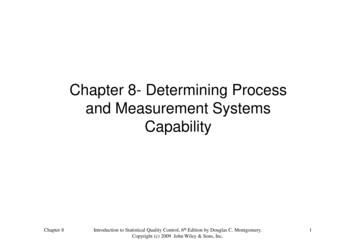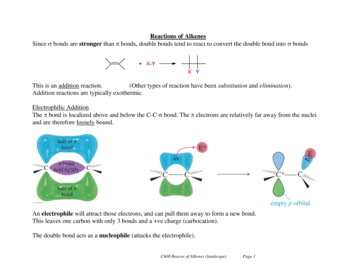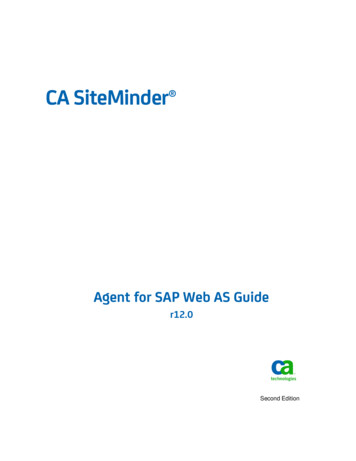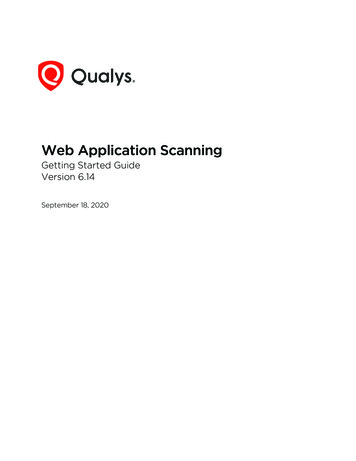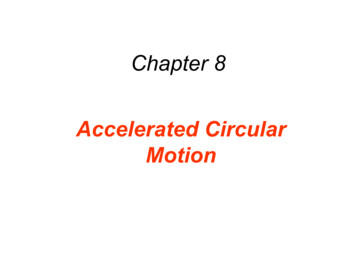
Transcription
Chapter 8Accelerated CircularMotion
8.1 Rotational Motion and Angular DisplacementA new unit, radians, is really useful for angles.Radian measures (arc length)θ (radians) r (radius)sθrs rθ(s in same units as r)Full circles2π rθ rr 2π (radians)Conversion of degree to radian measure 2π rad θ (rad) θ (deg.) 360 deg. 2π rad 360 deg. 1
8.1 Rotational Motion and Angular DisplacementExample: Adjacent Synchronous SatellitesSynchronous satellites are put intoan orbit whose radius is 4.23 107m.If the angular separation of the twosatellites is 2.00 degrees, find thearc length that separates them.Convert degree to radian measure 2π rad 2.00deg 0.0349 rad 360deg Determine arc length()s rθ 4.23 107 m ( 0.0349 rad ) 1.48 106 m (920 miles)
8.1 Rotational Motion and Angular DisplacementFor an observer on the earth, an eclipse can occur becauseangles subtended by the sun and the moon are the same.sSun sMoonθ 9.3 mradrSun rMoon
8.1 Rotational Motion and Angular DisplacementThe angle through which theobject rotates is called theangular displacement vectorΔθ θ θ oSI unit of angulardisplacement, radian (rad)Simplified using θ o 0, andΔθ θ , angular displacement vector.VectorCounter-clockwise is displacementClockwise is – displacementrΔθθ0 0
Clicker Question 8.1 Radian measure for anglesOver the course of a day (twenty-four hours), what is the angulardisplacement of the second hand of a wrist watch in radians?a) 1440 radb) 2880 radc) 4520 radd) 9050 rade) 543,000 rad
Clicker Question 8.1 Radian measure for anglesOver the course of a day (twenty-four hours), what is the angulardisplacement of the second hand of a wrist watch in radians?a) 1440 radb) 2880 radc) 4520 radd) 9050 rade) 543,000 radSecond hand makes 1 rev. in 1 minute.1 day (1 day)(60 min./hr)(24 hr/day) 1440 min.# rev. (1 rev./min.) (1440 min.) 1440 rev.1 rev. 2π radiansTotal θ displacement (2π rad/min.)(1440 min.) 9048 rad
8.2 Angular Velocity and Angular AccelerationDEFINITION OF AVERAGE ANGULAR VELOCITYΔθω Δtwhere Δt t toSI Unit of Angular Velocity: radian per second (rad/s)Δθ is the same at all radii.Δt is the same at all radii.Δθω is the same at all radii.Δtr1 r2 Angle changeΔθ in time ΔtΔθθ0 0
8.2 Angular Velocity and Angular AccelerationωCase 1: Constant angular velocity, ω .rΔθω ΔtΔθ ω ΔtΔθExample: A disk rotates with a constant angular velocity of 1 rad/s.What is the angular displacement of the disk in 13 seconds?How many rotations has the disk made in that time?Δθ ω Δt ( 1 rad/s)(13 s) 13 rad2π radians 1 rotation 2π rad/rot.Δθ13 radnrot 2.1 rot.2π rad/rot. 6.3 rad/rotθ0 0
8.2 Angular Velocity and Angular AccelerationCase 2: Angular velocity, ω ,changes in time.Instantaneousangular velocityat time t.ωrΔθω limΔt 0 ΔtDEFINITION OF AVERAGE ANGULAR ACCELERATIONSI Unit of Angular acceleration: radian per second squared (rad/s2)ω0
8.2 Angular Velocity and Angular AccelerationExample: A Jet Revving Its EnginesAs seen from the front of theengine, the fan blades arerotating with an angularvelocity of –110 rad/s. As theplane takes off, the angularvelocity of the blades reaches–330 rad/s in a time of 14 s.Rotation is clockwise (negative)Find the angular acceleration, assuming it tobe constant. 330rad s ) ( 110rad s )(α 16rad s14 s2
8.2 The Equations of Rotational KinematicsThe equations of rotational kinematics for constantangular acceleration:ANGULAR ACCELERATIONANGULAR VELOCITYω ω0 α tθ 12(ω0 ω)tANGULAR DISPLACEMENTω 2 ω 02 2αθθ ω 0t 12 α t 2TIME
8.2 The Equations of Rotational Kinematics
8.2 The Equations of Rotational KinematicsReasoning Strategy1. Make a drawing.2. Decide which directions are to be called positive ( ) andnegative (–).3. Write down the values that are given for any of the fivekinematic variables.4. Verify that the information contains values for at least threeof the five kinematic variables. Select the appropriate equation.5. When the motion is divided into segments, remember thatthe final angular velocity of one segment is the initial angular velocityfor the next.6. Keep in mind that there may be two possible answers to akinematics problem.
Clicker Question 8.2 Rotational motion kinematicsGiven the initial and final angular velocity of a disk and the totalangular displacement of the disk, the angular acceleration ofof the disk can be obtained with which single equation?a) ω ω 0 α tb) θ 12 (ω ω 0 )tc) θ ω 0t 12 α t 2d) ω 2 ω 02 2αθe) none of the above
Clicker Question 8.2 Rotational motion kinematicsGiven the initial and final angular velocity of a disk and the totalangular displacement of the disk, the angular acceleration ofof the disk can be obtained with which single equation?a) ω ω 0 α tb) θ (ω ω 0 )t12c) θ ω 0t α t122d) ω ω 2αθ220e) none of the aboveNo time given!ω 2 ω 02 2αθω 2 ω 02α 2θ
8.2 The Equations of Rotational KinematicsExample: A disk has an initial angular velocity of 375 rad/s.The disk accelerates and reaches aωgreater angular velocity after rotatingrthrough an angular displacementof 44.0 rad.If the angular acceleration has aconstant value of 1740 rad/s2,find the final angular velocity of the disk.Given: ω 0 375 rad/s, θ 44 rad, α 1740 rad/s 2Want: final angular velocity, ω .ω 2 ω 02 2αθ (375 rad/s)2 2(1740 rad/s 2 )( 44 rad)ω 542 rad/sNo time!ω0
8.3 Angular Variables and Tangential Variablesω angular velocity - same at all radii (radians/s)2α angular acceleration - same at all radii (radians/s ) v T tangential velocity - different at each radius a T tangential acceleration - different at each radiusDirection is tangent to circle at that θ vT ω raT α r v T (m/s) a T (m/s 2 )ω (rad/s)r (m)α (rad/s 2 )r (m)
8.3 Angular Variables and Tangential VariablesExample: A Helicopter BladeA helicopter blade has an angular speed of 6.50 rev/s and anangular acceleration of 1.30 rev/s2.For point 1 on the blade, findthe magnitude of (a) thetangential speed and (b) thetangential acceleration.Convert revolutions to radians! ( 6.50 rev s ) ( 2" rad rev ) 40.8 rad s()! 1.30 rev s 2 ( 2" rad rev ) 8.17 rad s 2vT ! r ( 40.8rad s ) ( 3.00 m ) 122m s(aT " r 8.17 rad s2)(3.00 m ) 24.5m s2
8.3 Rolling MotionThe tangential speed of apoint on the outer edge ofthe tire is equal to the speedof the car over the ground.v vT ! ra aT ! r
8.3 Centripetal Acceleration with Tangential AccelerationvT ! r!aCrUniform circular motion! in rad/s constant!r)v(aC ! 2rrr2T2!ar!!aC!aTNon-uniform circular motionChanging ω ω 0 α taT ! ratotal aC2 ! 2 r 2
Chapter 4.5Force GeneratingUniform CircularMotion
4.5 Centripetal ForceNewtonʼs Second LawWhen a net external force acts on an objectof mass m, the acceleration that results isdirectly proportional to the net force and hasa magnitude that is inversely proportional tothe mass. The direction of the acceleration isthe same as the direction of the net force.Vector Equations
4.5 Centripetal ForceThus, in uniform circular motion there must be a netforce to produce the centripetal acceleration.The centripetal force is the name given to the net forcerequired to keep an object moving on a circular path.The direction of the centripetal force always points towardthe center of the circle and continually changes directionas the object moves.2vFC maC mrMagnitudes
4.5 Centripetal ForceExample: The Effect of Speed on Centripetal ForceThe model airplane has a mass of 0.90 kg and moves atconstant speed on a circle that is parallel to the ground.The path of the airplane and the guideline lie in the samehorizontal plane because the weight of the plane is balancedby the lift generated by its wings. Find the tension in the 17 mguideline for a speed of 19 m/s.Tension vectorpoints inward!2vT FC mrT
4.5 Centripetal ForceExample: The Effect of Speed on Centripetal ForceThe model airplane has a mass of 0.90 kg and moves atconstant speed on a circle that is parallel to the ground.The path of the airplane and the guideline lie in the samehorizontal plane because the weight of the plane is balancedby the lift generated by its wings. Find the tension in the 17 mguideline for a speed of 19 m/s.Tension is the centripetal force necessary to maintainairplane in the circle2vT FC mrengine keeps speed upwings keep it from fallingTension vectorpoints inward!T
4.5 Centripetal ForceConceptual Example: A Trapeze ActIn a circus, a man hangs upside down from a trapeze, legsbent over and arms downward, holding his partner. Is it harderfor the man to hold his partner when the partner hangsstraight down and is stationary or when the partner is swingingthrough the straight-down position?Tension in armsmaintains circular motionbut also must counter thegravitational force (weight)
4.5 Centripetal ForceConceptual Example: A Trapeze ActIn a circus, a man hangs upside down from a trapeze, legsbent over and arms downward, holding his partner. Is it harderfor the man to hold his partner when the partner hangsstraight down and is stationary or when the partner is swingingthrough the straight-down position?Tension in armsmaintains circular motionbut also must counter thegravitational force (weight)v2FC mr F T W FCT W FCTvvW mg
4.5 Banked CurvesOn an unbanked curve, the static frictional forceprovides the centripetal force.
4.5 Banked CurvesOn a frictionless banked curve, the centripetal force is thehorizontal component of the normal force. The verticalcomponent of the normal force balances the carʼs weight.Compression of the banked road provides the normal force. Thenormal force pushes against the car to 1) support the weight and 2)provides the centripetal force required for the car to move in a circle.
4.5 Banked Curves2vFC FN sin ! mrCombining the two relationships can determine the speed necessaryto keep the car on the track with the given angle
4.5 Artificial GravityExample: Artificial GravityAt what speed must the surface of a space station moveso that an astronaut experiences a normal force on the feetequal to the weight on earth? The radius is 1700 m.v rg (1700 m )(9.80m s ) 130 m/s2
4.5 Vertical Circular MotionNormal forces are created by stretching of the hoop.v32must be grto stay on the trackv42FN 4 mr
8.2 The Equations of Rotational Kinematics Example: A disk has an initial angular velocity of 375 rad/s. The disk accelerates and reaches a greater angular velocity after rotating through an angular displacement of 44.0 rad. If the angular acceleration has a constant value of 1740 rad/s2, find the final angular velocity of the disk. r ω ω 0



